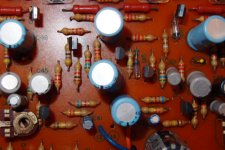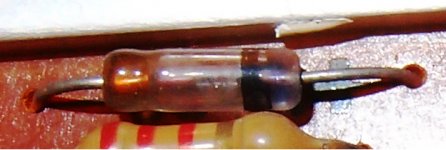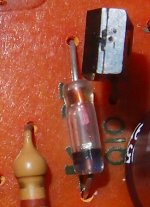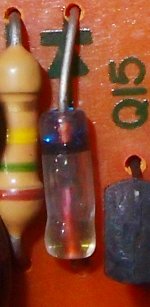Hello folks!
I have recapped an Audio Sonic ST-500 integrated (all the 35 electrolytics, 6 ceramic caps, the 4 rectifiers, and two VD1212-like diodes with 2x 1N4448 in series).
And the board during recapping:
The sound is amazing!!! I was wondering if it's a little Kenwood or Pioneer based amp as back panel has "Japan" printing, but internet sources says it's a Dutch brand from the Seventies (1975) and seems that it still operates today somehow.
Another source says it's from Glendale, California...
However, after the recap I still have (only on RIGHT channel) an annoying and PERMANENT noisy sound like a "hissssss" or "sssssssh" even when the volume pot is totally attenuated. When I'm listening to music in normal volume levels I can't hear the noise anymore because it's now overcome by the music sound. But in silent passages of the music or during radio interviews and news it is quite annoying.
I was thinking it could be a TR or a Zener diode or a high power resistor?
I'd need to know if the highlighted diodes below are Zener ones and if I can replace the with few I have in stock, rated 1,3W - 40V...
Or if you folks know or have an idea about this problem...
Thanks in advance!!
I have recapped an Audio Sonic ST-500 integrated (all the 35 electrolytics, 6 ceramic caps, the 4 rectifiers, and two VD1212-like diodes with 2x 1N4448 in series).
An externally hosted image should be here but it was not working when we last tested it.
And the board during recapping:
An externally hosted image should be here but it was not working when we last tested it.
The sound is amazing!!! I was wondering if it's a little Kenwood or Pioneer based amp as back panel has "Japan" printing, but internet sources says it's a Dutch brand from the Seventies (1975) and seems that it still operates today somehow.
Another source says it's from Glendale, California...
However, after the recap I still have (only on RIGHT channel) an annoying and PERMANENT noisy sound like a "hissssss" or "sssssssh" even when the volume pot is totally attenuated. When I'm listening to music in normal volume levels I can't hear the noise anymore because it's now overcome by the music sound. But in silent passages of the music or during radio interviews and news it is quite annoying.
I was thinking it could be a TR or a Zener diode or a high power resistor?
I'd need to know if the highlighted diodes below are Zener ones and if I can replace the with few I have in stock, rated 1,3W - 40V...
An externally hosted image should be here but it was not working when we last tested it.
Or if you folks know or have an idea about this problem...

Thanks in advance!!
Last edited:
No, it's impossible to find.The resistors look like they are a Russian design.
Have you a schematic?

Also fo the adjustments of DC Offset and Bias, I'm relying on the mid position of the only 2 variable resistors in the board...
The pictures below were taken before recapping...
Attachments
Hi folks,
Please, could you identify these diodes? (pics attached below, now enlarged samples)
There are three of them in the board I highlighted above.
I need to know if they are Zener ones or diodes for protection circuit.
My amp has a permanent "hiss" on right channel and I can't get rid of it! 🙁
Any help would be much appreciated! 😱
Please, could you identify these diodes? (pics attached below, now enlarged samples)
There are three of them in the board I highlighted above.
I need to know if they are Zener ones or diodes for protection circuit.
My amp has a permanent "hiss" on right channel and I can't get rid of it! 🙁
Any help would be much appreciated! 😱
Attachments
Hoi Karl,
Aan je gegevens te zien ben je nederlands. Ik heb zelf 2 van deze versterkers gehad. In mijn jeugd had ik de complete zet. Twee weken geleden de laatste versterker verkocht. Beide versterkers hadden last van deze ruis in het rechter kanaal. Ik weet nog uit mijn jeugd dat dit ook al zo was. De versterker klinkt heerlijk warm als je hem niet te hard zet. De ruis wordt iets minder als je de filters gebruikt. Ik zou het knap vinden als de ruis eruit krijgt want vanuit de fabriek ruist hij al. Hopelijk heb ik je geholpen. De tuner heb ik nog en werkt prima. Intresse?
Aan je gegevens te zien ben je nederlands. Ik heb zelf 2 van deze versterkers gehad. In mijn jeugd had ik de complete zet. Twee weken geleden de laatste versterker verkocht. Beide versterkers hadden last van deze ruis in het rechter kanaal. Ik weet nog uit mijn jeugd dat dit ook al zo was. De versterker klinkt heerlijk warm als je hem niet te hard zet. De ruis wordt iets minder als je de filters gebruikt. Ik zou het knap vinden als de ruis eruit krijgt want vanuit de fabriek ruist hij al. Hopelijk heb ik je geholpen. De tuner heb ik nog en werkt prima. Intresse?

bigf00t72:
This is an English speaking forum. If you post in another language please include the English translation.
This is Google Translate:
Hi Karl,
To your data appears to be Dutch. I have 2 of these amps had. In my youth I had the complete set. Two weeks ago the last amplifier sold. Both amplifiers suffered from this noise in the right channel. I remember from my childhood that even though it was. The amp sounds warm if you do not move too fast. The noise is slightly less when the filters. I would find it pretty when the noise gets out from the factory because he murmurs al Hopefully I have helped you. The tuner I have and works fine. Intrested?
Hello.
Regards.
These are germanium diodes but hard to tell what reference!Hi folks,
I need to know if they are Zener ones or diodes for protection circuit.
Regards.
Also for the adjustments of DC Offset and Bias, I'm relying on the mid position of the only 2 variable resistors in the board...
Don't rely on unknown factors.
DC offset: can be measured easily, Volume on zero, no load, multimeter on DC mV setting and off you go. Adjust for lowest DC voltage on the output but do this when the amp has been powered on for at least 15 minutes.
Quiescent current/idling current: Volume on zero, no load, multimeter on DC mV. measure the voltage over one power transistors emitter resistor. Voltage divided by resistor value is current. I guess these were adjusted for very low current probably around 25 mA. First measure and then adjust both channels to the same current. Turn the potentiometer very slowly and by small movement. Don't be tempted to adjust the idling current to very high values with this amp. If you have a scope please check for crossover distortion and give it 10 mA more than the point where crossover distortion disappears.
BTW when recapping it is best to use fresh components. You have used caps that were made in 1991.
Diodes are indeed germanium types. They probably cause the noise/hiss. You could change them for 1N34A types but please measure U forward first. If it is around 0.3 V I would not hesitate to use BAT43 Schottky diodes that have 0.33 V Uf. Much more reliable, less leakage current and no noise. Please measure first as in that time sometimes diodes were used that were in fact a few diodes in series in one package. You can see that by checking Uf.
Last edited:
Thanks folks for all the answers!
Yes, I identified the diodes and they are Germanium. I replaced them with AA119. The sound was a bit treble at first, but now it's getting stable and warmer. I replaced these Germaniums because they had different values (from .230 up to .415 second my DMM).
But they are not the source of the noise I have in the right channel. The culprit are the noisy 2SC458 transistors (6 of them are in the board) and I'll replace them with BC549 or BC550.
Also "2SA673" and "2SC1214" will be replaced soon with BC327 and BC337 respectively:
Yes, I put that 100uF 25V Elna Duorex II from 1991 bcause the ERS was still good and so was the capacitance. The original cap was 100uF 16V from 1971.
Yes, I identified the diodes and they are Germanium. I replaced them with AA119. The sound was a bit treble at first, but now it's getting stable and warmer. I replaced these Germaniums because they had different values (from .230 up to .415 second my DMM).
But they are not the source of the noise I have in the right channel. The culprit are the noisy 2SC458 transistors (6 of them are in the board) and I'll replace them with BC549 or BC550.
An externally hosted image should be here but it was not working when we last tested it.
Also "2SA673" and "2SC1214" will be replaced soon with BC327 and BC337 respectively:
An externally hosted image should be here but it was not working when we last tested it.
An externally hosted image should be here but it was not working when we last tested it.
Yes, I put that 100uF 25V Elna Duorex II from 1991 bcause the ERS was still good and so was the capacitance. The original cap was 100uF 16V from 1971.
Very interesting. And what about the 1N5817? They are supposed to have 0.15V.Diodes are indeed germanium types. They probably cause the noise/hiss. You could change them for 1N34A types but please measure U forward first. If it is around 0.3 V I would not hesitate to use BAT43 Schottky diodes that have 0.33 V Uf. Much more reliable, less leakage current and no noise. Please measure first as in that time sometimes diodes were used that were in fact a few diodes in series in one package. You can see that by checking Uf.
Here are the old Germaniums:
An externally hosted image should be here but it was not working when we last tested it.
P.S: I have some Schottky BAT83! Would they be any suitble??
..
Last edited:
In the picture those tan and/or brown resistors look like carbon film types to me, just based on some ones I still got from Olsen years ago.
That's a grand looking classic amplifier.
If those diodes are working, I would not replace them.
Zeners above about 10 V are actually fairly quiet at 2-3 uV wide and noise - much better than say an LM317/337.
Did your amp make the ssshhhhh sound before you recapped?
If not, you may have a wrong value ( too low perhaps) on one of the disc ceramics, and the right chan is oscillating.
Sakis, where are you my friend?
😀
If those diodes are working, I would not replace them.
Zeners above about 10 V are actually fairly quiet at 2-3 uV wide and noise - much better than say an LM317/337.
Did your amp make the ssshhhhh sound before you recapped?
If not, you may have a wrong value ( too low perhaps) on one of the disc ceramics, and the right chan is oscillating.
Sakis, where are you my friend?
😀
Yes, they are Russian carbon film resistors. I kept them and replaced all the transistors instead.In the picture those tan and/or brown resistors look like carbon film types to me, just based on some ones I still got from Olsen years ago.
Amp was sold to a collector few months ago for a good offer.That's a grand looking classic amplifier.
If those diodes are working, I would not replace them.
Zeners above about 10 V are actually fairly quiet at 2-3 uV wide and noise - much better than say an LM317/337.
Did your amp make the ssshhhhh sound before you recapped?
The zener was still good, but the Germanium were not. I replaced them with BAT86 (or BAT83 I think) along with the old and noisy 2SC458 with the newer and much quieter BC550.
The "hisssss" was gone! 🙂
@Karl
well ...there has been many answers not much of them in the direction to solve the problem (s)
here is some things to notice Karl ...
Generally you should do some reading before performing a repair or upgrade for a vintage amplifier ...there is one article by me here Q http://www.diyaudio.com/forums/solid-state/136261-vintage-amplifier-repair-upgrade-manual.html but obviously you will find a gozilion other remarks about the issue .
It is a poor choice to replace the capacitors of such an amplifier with the same values like the original . The benefit of beefing up the power supply caps to almost 4 to 10 times up will change your amp for the best almost 10 times .
Then again the approach of changing anything you find in front of you to trace the problem is almost childish and will cause more trouble than solution
Beyond voltage /current ratings in a transistor to be replaced there is other very important things like hfe /beta/capacitance /and ft that makes BC transistors NOT direct replacements or drop in replacements to Japanese transistors, Not to mention that you will probably find that the original semis was either closely matched or at least in a total level of a common acceptable tolerance.
There is a chance that your choices will may be work but performance and stability will never be the same . Specifically for your amplifier that doesn't feature a bias setting altering the specs of any transistor will result altering the bias ...then its kaboooooom
Additionally the Japanese Industry was extremely careful when it comes to choice and quality of semis meaning that even small stupid transistors where chosen for specific grade of performance hfe and ft The choice was NOT random but mostly a result of a very good study .
There is 2 good ways to find your trouble without killing your amp by replacing everything with BC transistors
1) will be to measure voltage drop over the resistors that feed these transistors comparing one ch with the other and where ever you notice difference above 10% you should look closer for a leaky transistor
2)A classic way will also be to use a freezer spray to freeze for a moment transistors one behind the other while at """hiss mode """ and if hiss is gone with freeze then just replace the leaky transistor .
@others and Karl
Gents please look closer !!
***This amplifier is single supply capacitor coupled with a single transistor in the input NO LTP ...so also no offset adjustment plus that readings in the output are tricky and might confuse you cause of the leak on the output capacitors
***Usually amplifiers of that simplicity and also the ones that feature no Vbe multiplier and format bias with a couple of diodes THAT YOU SHOULD NOT CHANGE IF WORKING normally also dont have bias trimmers
*** Classic Quasi amplifiers of single supply capacitor coupled feature a symmetry or midpoint trimmer adjustment and this is one is tuned to exactly half the power supply voltage measuring from ground to + of the 1000mfd ( which is very poor and low value ) output coupling capacitor ...
With respect
Kind regards
Sakis
( will spend some time look for a schematic or try to locate the original manufacturer so you may drug some info from there ... you never know what will come up )
well ...there has been many answers not much of them in the direction to solve the problem (s)
here is some things to notice Karl ...
Generally you should do some reading before performing a repair or upgrade for a vintage amplifier ...there is one article by me here Q http://www.diyaudio.com/forums/solid-state/136261-vintage-amplifier-repair-upgrade-manual.html but obviously you will find a gozilion other remarks about the issue .
It is a poor choice to replace the capacitors of such an amplifier with the same values like the original . The benefit of beefing up the power supply caps to almost 4 to 10 times up will change your amp for the best almost 10 times .
Then again the approach of changing anything you find in front of you to trace the problem is almost childish and will cause more trouble than solution
Beyond voltage /current ratings in a transistor to be replaced there is other very important things like hfe /beta/capacitance /and ft that makes BC transistors NOT direct replacements or drop in replacements to Japanese transistors, Not to mention that you will probably find that the original semis was either closely matched or at least in a total level of a common acceptable tolerance.
There is a chance that your choices will may be work but performance and stability will never be the same . Specifically for your amplifier that doesn't feature a bias setting altering the specs of any transistor will result altering the bias ...then its kaboooooom
Additionally the Japanese Industry was extremely careful when it comes to choice and quality of semis meaning that even small stupid transistors where chosen for specific grade of performance hfe and ft The choice was NOT random but mostly a result of a very good study .
There is 2 good ways to find your trouble without killing your amp by replacing everything with BC transistors
1) will be to measure voltage drop over the resistors that feed these transistors comparing one ch with the other and where ever you notice difference above 10% you should look closer for a leaky transistor
2)A classic way will also be to use a freezer spray to freeze for a moment transistors one behind the other while at """hiss mode """ and if hiss is gone with freeze then just replace the leaky transistor .
@others and Karl
Gents please look closer !!
***This amplifier is single supply capacitor coupled with a single transistor in the input NO LTP ...so also no offset adjustment plus that readings in the output are tricky and might confuse you cause of the leak on the output capacitors
***Usually amplifiers of that simplicity and also the ones that feature no Vbe multiplier and format bias with a couple of diodes THAT YOU SHOULD NOT CHANGE IF WORKING normally also dont have bias trimmers
*** Classic Quasi amplifiers of single supply capacitor coupled feature a symmetry or midpoint trimmer adjustment and this is one is tuned to exactly half the power supply voltage measuring from ground to + of the 1000mfd ( which is very poor and low value ) output coupling capacitor ...
With respect
Kind regards
Sakis
( will spend some time look for a schematic or try to locate the original manufacturer so you may drug some info from there ... you never know what will come up )
forgot that one and might be critical ...i can supply you ( but you can also find many on you own) schematics that if not the same will be very close to what you have
If the diodes you replaced are nested in the bias area and values are different there is a very good chance that bias is now altered .
Amplifier is simple enough for a hand drawn schematic
At least verify the bias before and after the changes you made ...Bias is easy to measure like mentioned above but oscillation will be not easy to listen and often can be perceived by listeners as ""plenty of high ""
Both oscillation and bias higher than supposed to be will eventually end up in kabooooom
Kind regards
Sakis
If the diodes you replaced are nested in the bias area and values are different there is a very good chance that bias is now altered .
Amplifier is simple enough for a hand drawn schematic
At least verify the bias before and after the changes you made ...Bias is easy to measure like mentioned above but oscillation will be not easy to listen and often can be perceived by listeners as ""plenty of high ""
Both oscillation and bias higher than supposed to be will eventually end up in kabooooom
Kind regards
Sakis
Thank you Sakis! 🙂
Really, much appreciated all the remarks here, indeed! 🙂
The BC550 TRs that replaced the 2SC458 came after a reseach here and from other forums. The BC550 one was a common choice among a few people, so I had to rely on them. The damaged 2SC458 was replaced and the hiss' gone.
Folks say that: "ALL THE OLD 2SC458 IN ANY EQUIPMENT SHOULD BE REPLACED BECAUSE THEY ARE VERY NOISY, NOT EFFICIENT AND PRONE TO DAMAGE". So I just followed their advice. Same thing for the Germanium diodes. Fact is that that amp at the end came dead quiet and I guess it's still running so. I asked the guy who bought it to contact me if something wrong happens because I was also interested to know if all the replacements done were good.
But, yeah, you're right when a closer look should have to be done. I'd probably have done that at the time I opened this thread.
But the following is very VERY interesting:
Really, much appreciated all the remarks here, indeed! 🙂
The BC550 TRs that replaced the 2SC458 came after a reseach here and from other forums. The BC550 one was a common choice among a few people, so I had to rely on them. The damaged 2SC458 was replaced and the hiss' gone.
Folks say that: "ALL THE OLD 2SC458 IN ANY EQUIPMENT SHOULD BE REPLACED BECAUSE THEY ARE VERY NOISY, NOT EFFICIENT AND PRONE TO DAMAGE". So I just followed their advice. Same thing for the Germanium diodes. Fact is that that amp at the end came dead quiet and I guess it's still running so. I asked the guy who bought it to contact me if something wrong happens because I was also interested to know if all the replacements done were good.
An externally hosted image should be here but it was not working when we last tested it.
But, yeah, you're right when a closer look should have to be done. I'd probably have done that at the time I opened this thread.
But the following is very VERY interesting:
So you recommend to push power caps value from, let's say, 10,000uF up to much higher?@Karl
...
It is a poor choice to replace the capacitors of such an amplifier with the same values like the original . The benefit of beefing up the power supply caps to almost 4 to 10 times up will change your amp for the best almost 10 times .
Last edited:
And this applies only for the Power Supply capacitors, right?
Or is there any other part in the circuit capacitance levels can be increased?
Or is there any other part in the circuit capacitance levels can be increased?
This one looks 1N60 or something alike...Germanium diodes
Well....someone said it is not a germanium.
Well this is easy to know...measure the voltage drop... if 200 milivolts..then it is a Germanium.
Sakis may know this stuff.
regards,
Carlos
Well....someone said it is not a germanium.
Well this is easy to know...measure the voltage drop... if 200 milivolts..then it is a Germanium.
Sakis may know this stuff.
regards,
Carlos
- Status
- Not open for further replies.
- Home
- Amplifiers
- Solid State
- Audio Sonic ST-500 integrated




